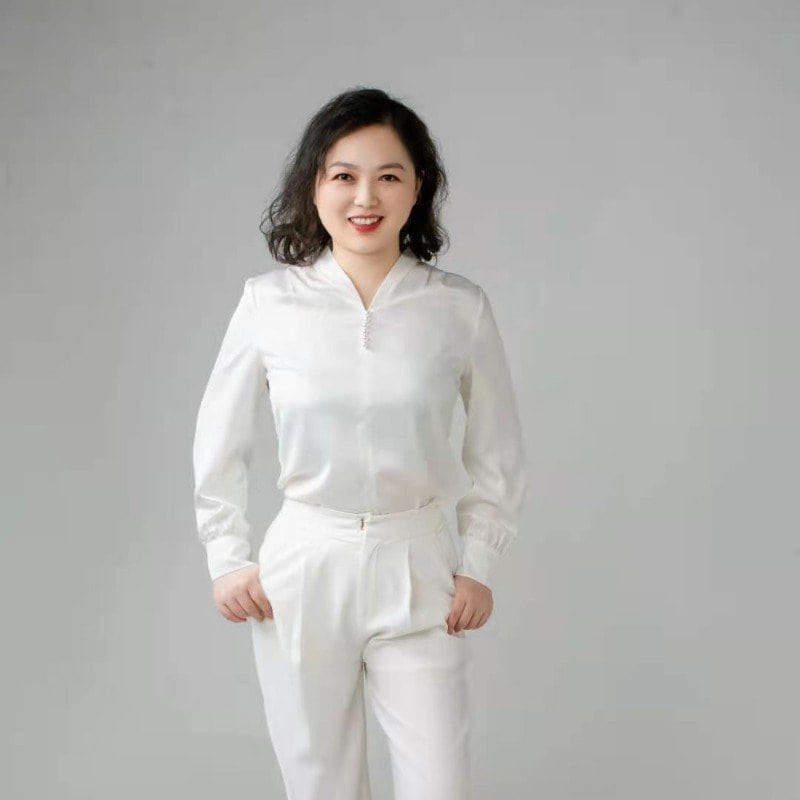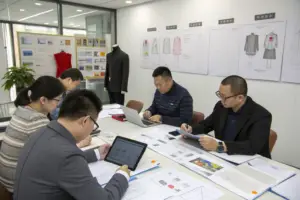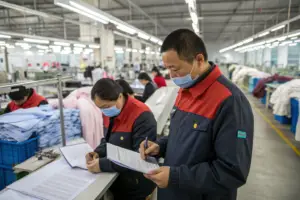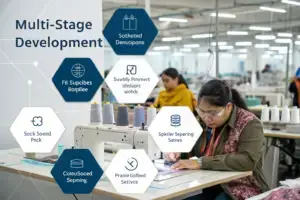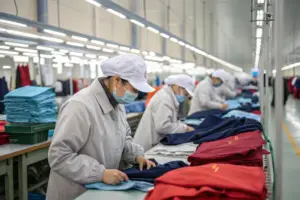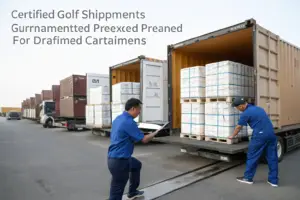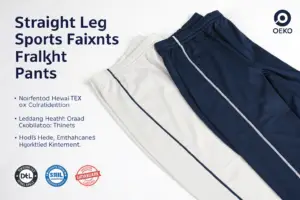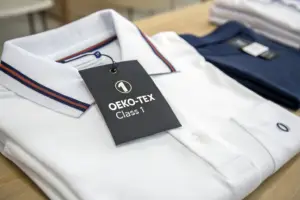The secret of textile materials' ability to change like "chameleon" comes from the mechanically sensitive color-changing materials. Changes in external environmental factors induce the molecular structure of color-changing materials to produce rearrangement, ring-opening and ring-closing, and mutually variable isomerization, resulting in changes in the conjugation system in the molecular structure, thus changing the color of the material on the surface.
In nature, there are many plants and animals that can change their colors according to the environment. While marveling at the wonders of the world, people are actively drawing inspiration from nature to develop materials with "color-changing" functions.
Unlike most color-changing materials in the research and development stage, intelligent color-changing textile materials have the widest application prospect, and some of them have been industrialized and appeared in daily life. Professor Ma Xiaoguang of the School of Textile Science and Engineering of Tianjin University of Technology said that intelligent color-changing textile materials have unique intelligent reversible color-changing characteristics while maintaining the basic function of textile products, the function, fashion, etc. into one, favored by the market.
Sensitive color-changing materials are the mystery of textile "fickleness"
"As the name implies, intelligent color-changing textile material (color-changing fiber/fabric) is an intelligent textile that can respond to changes in external environmental factors." Ma introduced the color-changing materials added to textile materials, the color of textile materials will be stimulated by light sources, temperature and other external environmental factors, reversible changes, thus creating a brilliant and colorful visual effect.
Intelligent color-changing textile materials can be as good as "chameleon", its mystery mainly from the mechanically sensitive color-changing materials. Changes in external environmental factors induce the molecular structure of color-changing materials to produce rearrangement, open-loop and closed-loop, mutually variable isomerism and other changes, resulting in changes in the conjugation system in the molecular structure, thus making the material change color on the surface. Depending on the mechanosensitive color-changing materials, smart color-changing textile materials can be mainly divided into photochromic textile materials and thermochromic textile materials.
However, the development and preparation of intelligent color-changing textile materials is not a simple 1+1="2" addition of mechanochromatic materials and textile materials, the combination of mechanochromatic materials and textile materials, there are various technical routes and corresponding processing processes such as interlayer method, impregnation method, coating method, cross-linking method, microencapsulation method, fiber filling method, fiber grafting method, fiber formation method.
"The reversible color change characteristics of textiles depend on the color change performance of the mechanosensitive color change materials. And the performance of mechanosensitive color-changing materials is related to the choice of technical route and the level of processing technology." Ma said the current combination of these methods has its own advantages and disadvantages. For example, the impregnation method is to impregnate the fabric in a dispersion made from mechanosensitive materials, so that the mechanosensitive materials are adsorbed on the fabric. Although this method is simple and easy to operate, the product's fastness is poor, not washable, generally for one-time use only; the filler fiber method is to fill the mechanosensitive materials into the hollow fiber, and then textile made of smart fabrics. This preparation method can maintain a high intelligent color change effect, but the filling process is complex and costly, which brings some difficulties to the actual production.
Can "show off" in multiple applications
As early as in Alexander Wang's Fall/Winter 2014 collection, designer Wang Daren applied thermochromic inks to fabrics, combining multiple ink color blocking methods to make fabrics show a reversible effect of changing from black to color while combining laser cutting and weaving techniques to make the works successfully attract the audience's attention.
"The application fields of intelligent color-changing textiles are currently very broad. For example, in the fashion industry, especially in recent years, more and more international fashion brands have started to try to apply thermochromic materials in ready-to-wear designs, combining intelligent color change with garment design."
"In the field of general civilian clothing, we combine smart color-changing clothing with sensor pieces can also achieve emotional expression, health monitoring, and other purposes." For example, for example, sportswear designed to monitor endurance and an athlete's skin temperature can keep track of an athlete's physical fatigue level in real-time through changes in clothing color.
In addition, the application of color-changing materials in disease diagnosis and other areas has also attracted great interest. For example, the temperature of various parts of the human body is an important basis for disease diagnosis, scientists use liquid crystal-like thermochromic materials to design textile patches that can be sensitive monitoring of human body temperature for the early detection of infections and blood circulation changes.
"In the 21st century, textile materials with thermochromic function are also increasingly used in aerospace, military, and other fields. Also, good economic and social benefits have been achieved in the development of related color-changing industrial fabrics, decorative fabrics, protective clothing, etc." We are very optimistic about the application prospect of intelligent color-changing textiles.
Large-scale industrialization is still facing constraints
"With the development of science and technology, low cost and excellent performance of machine-sensitive color-changing materials have been developed one after another, and some have been industrialized, promoting the formation of the machine-sensitive color-changing materials industry chain, which has greatly promoted the development of color-changing intelligent textile materials." Ma Xiaoguang introduced that China has gradually improved the relevant processing technology and become one of the few countries that can produce color-changing intelligent textile materials together with the United Kingdom, the United States, and Japan.
"On the whole, intelligent color-changing textiles are still in the process of research and development promotion all over the world. Due to the limitations of the types of machine-sensitive color-changing materials and application technology, it will take time to industrialize on a large scale." Ma Xiaoguang explained that there are many kinds of materials that can produce the color-changing effect, but the machine-sensitive color-changing materials that are suitable for textile substrate materials and can be used to prepare intelligent reversible color-changing textiles require wide color-changing chromatography, sensitive response, reversible fast response rate; stable color-changing system and do not damage the textile substrate; environmental protection, low cost, etc., so there is little room for choice.
In addition, the current color-changing materials generally have the defect of narrow color change range, mostly changing within the same warm and cold hue, for example, from grass green (cool hue) to purple-blue (cool hue); or only changing color depth within the same color area, for example, from dark blue to light blue, etc.
"Color-changing chromatograms that can span hues and go beyond similar colors are rare, and those with excellent performance that can eventually be practically applied are even rarer." Ma believes that the single color change and shortage of chromatography greatly limit the application of mechanically sensitive color-changing materials and the development of intelligent color-changing textiles.
Therefore, for the research and development of new color-changing materials, obtaining a comprehensive and extended color-changing chromatography is a very important topic and a critical issue to be solved for the development of wide-area chromatographic reversible intelligent color-changing textiles.
Researchers have been actively exploring this issue and have designed and constructed a composite system of thermochromic materials and special dyes by combining optimized special dyes with the basic color-changing system. Through the principle of complementarity, the color of this new thermochromic material can be reversibly changed between different cold and warm tones, exhibiting a wider color change range and a rich thermochromic color spectrum.
Based on the above work, the group has developed a thermochromic system that can continuously change several colors, realized the control of color change temperature and color change shade of thermochromic textiles, and developed a new thermochromic textile with wide color change chromatogram, obvious color difference, and high precision.
Future development requires precise design of color change performance
"With the continuous in-depth research on various types of intelligent textile materials, the multi-functional fusion of intelligent color-changing textile materials is bound to be the future development direction." For example, by combining the resistance heating performance of conductive fabrics and the color-changing performance of thermochromic materials, the problem of the passive color change of thermochromic fabrics can be solved, but also through the precise control of the temperature of the heated fabric, combined with the color superposition of thermochromic materials to achieve a variety of color changes in thermochromic fabrics; and photo-thermochromic fabrics, is the use of daylight-responsive heating layer in the sunlight irradiation of photothermal conversion performance to achieve color adjustment.
In different application areas, products have different needs for color change performance. In order to further develop intelligent color-changing textile materials, the color-changing properties of color-changing textile materials need to be designed in a targeted manner. For example, for different application scenarios, garments with diverse color-changing effects will be developed and combined with various apparel in people's daily life, so that the products can not only meet the needs of the public but also have broad market prospects.
"Intelligent color-changing textiles as a high value-added product, its development is in line with the '14th Five-Year' Development Plan of the textile industry 'to accelerate the breakthrough of key technologies of high-functional textile consumer products, intelligent fibers, and products and other advanced textile products ' requirements." Ma Xiaoguang believes that although the market prospect is very good, but only under the premise of grasping the safety, environmental protection, and durability of textiles, taking into account the style design, color change, fabric selection, and comfort and hygiene, etc., can better improve the market competitiveness of intelligent color-changing textiles.


